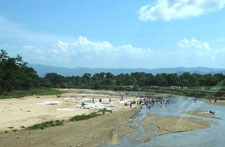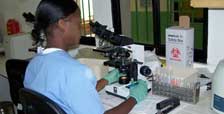In September 2008, The Carter Center, in partnership with the Dominican Republic and Haiti, launched a historic 18-month initiative to help the two countries and their other partners accelerate the elimination of two devastating mosquito-borne infections — malaria and lymphatic filariasis — from Hispaniola. The only island in the Caribbean that still has malaria, Hispaniola also contains more than 90 percent of all lymphatic filariasis remaining in the Americas. Both diseases are more prevalent in Haiti than in the Dominican Republic.
The initiative stemmed from a 2006 recommendation of the Carter Center-sponsored International Task Force for Disease Eradication (ITFDE) — a group of 12 global experts on infectious disease — that it is "technically feasible, medically desirable, and would be economically beneficial," to eliminate these two parasitic diseases from Hispaniola. Since then, the binational project has made great strides in collaborations between these two countries for the betterment of public health on the entire island. (Read the 2008 Carter Center Press Release: Carter Center Launches Effort to Spur Elimination of Malaria and Lymphatic Filariasis in Haiti and the Dominican Republic.)
Malaria and lymphatic filariasis are costly economic burdens, as both diseases are caused by, and create, additional poverty. An outbreak of malaria on the island in 2004 cost the Dominican Republic an estimated US $200 million in lost revenue from tourism. Since then, two transient outbreaks of malaria in the Bahamas and another in Jamaica have been imported from the island of Hispaniola, which also is the source of several cases of malaria imported to the U.S. each year.
 (All Photos: The Carter Center) The Dajabón or Massacre River is a natural border between the Dominican Republic and Haiti and was the focus of an 18-month Carter Center initiative to accelerate the elimination of malaria and lymphatic filariasis from the island of Hispaniola.
(All Photos: The Carter Center) The Dajabón or Massacre River is a natural border between the Dominican Republic and Haiti and was the focus of an 18-month Carter Center initiative to accelerate the elimination of malaria and lymphatic filariasis from the island of Hispaniola.
 A specially trained microscopist reads a blood smear from a patient who came to the Centre Medico-Social hospital in Ouanaminthe, Haiti with a fever and wanted to be tested for malaria. The microscope - purchased with support from The Carter Center allows the technician to see the slides more clearly without straining her eyes. The Centre Medico-Social hospital, which serves the greater community of 100,000 persons, provides free testing and treatment for malaria as part of the binational effort to eliminate malaria and lymphatic filariasis from the island of Hispaniola.
A specially trained microscopist reads a blood smear from a patient who came to the Centre Medico-Social hospital in Ouanaminthe, Haiti with a fever and wanted to be tested for malaria. The microscope - purchased with support from The Carter Center allows the technician to see the slides more clearly without straining her eyes. The Centre Medico-Social hospital, which serves the greater community of 100,000 persons, provides free testing and treatment for malaria as part of the binational effort to eliminate malaria and lymphatic filariasis from the island of Hispaniola.
With assistance from The Carter Center, the nations' health officials targeted malaria in two border towns joined by a bridge over the Dajabón or Massacre, River: Dajabón, Dominican Republic (pop. 27,000), and Ouanaminthe, Haiti (pop. 92,000). The towns constitute the most important commercial exchange area of the Haiti-Dominican border. Lymphatic filariasis and malaria were targeted through a smaller effort in a third town in Haiti, Trou-du-Nord (pop. 40,000).
The Carter Center initiative purchased insecticide-treated bed nets, microscopes, computers, motorbikes, and other materials; funded additional health staff in the three targeted communities; and provided technical assistance. Funding was channeled via the National Center for Control of Tropical Diseases, an agency of the Dominican Republic's Ministry of Public Health and Social Assistance, and the Centers for Development and Health, a Haitian nongovernmental organization working directly with the Haitian Ministry of Public Health and Population.
Through these efforts, the technical objectives of the binational project in Dajabón and Ouanaminthe have been met: the countries have developed a standard protocol and procedures, including free diagnosis and treatment of malaria; primaquine has been added as a tool for treatment of malaria; and surveillance and use of microscopy to confirm diagnosis of malaria has been intensified.
With support from The Carter Center, the Dominican Republic and Haiti prepared binational plans to complete elimination of both the diseases from the island. The total cost for the binational plan for malaria elimination (US $193.9 million) is less than one year of the Dominican Republic's lost tourism revenue due to malaria on the island. The lymphatic filariasis elimination plan (US $49.4 million) seeks to end the disease by 2020, in line with global elimination efforts of the disease.
In October 2009, former U.S. President Jimmy Carter led a Carter Center delegation to the Dominican Republic and Haiti to underscore and stimulate international support for the binational plan to complete elimination of both diseases from Hispaniola. The delegation also included former First Lady Rosalynn Carter, Carter Center President and CEO Dr. John Hardman, Vice President for Health Programs Dr. Donald Hopkins, and Malaria Control Program Director Dr. Frank Richards.
In January 2010, Haiti experienced a massive earthquake, causing significant loss of life and physical destruction. Read the Carter Center statement on the earthquake >
As recovery efforts from the earthquake continued, in March 2010, Carter Center Vice President for Health Programs Dr. Donald Hopkins published a letter to the editor in the New York Times on the importance of continuing efforts to eliminate malaria and lymphatic filariasis from the island of Hispaniola. Read the New York Times letter to the editor: A Project for Haiti: The Eradication of Two Diseases >
Efforts to support elimination continued, and in 2012, with Carter Center support, four binational meetings were held aimed at revising the binational malaria and lymphatic filariasis plans. Participants in these meetings included: The Carter Center, the technical teams of the National Center for Tropical Disease Control, the Dominican Republic's Ministry of Health, the National Malaria Control Program of the Haitian Ministry of Health, the Panamerican Health Organization, and the U.S. Centers for Disease Control and Prevention.
Malaria, a major cause of death for young children and pregnant women, causes incapacitating fevers and flu-like symptoms. It can be eliminated from Hispaniola because the parasite is still sensitive to chloroquine (a safe and inexpensive antimalarial drug); the local mosquito vector (Anopheles) is relatively inefficient in transmitting the infection; the lethal predominant parasite (Plasmodium falciparum) has no dormant phases; the two ministries of health and their partners are supporting indoor residual spraying and distribution of long-lasting insecticidal nets; and all other Caribbean islands already have eliminated the infection.
Lymphatic filariasis, especially in Haiti, is tightly intertwined with poverty, which is both a contributing cause and a result of the disease. Although not fatal, lymphatic filariasis is a debilitating disease that causes severe swelling in the limbs and genitals, which often devastates victims socially, emotionally, economically, and physically. Lymphatic filariasis can be eliminated on the island because the parasite (Wuchereria bancrofti) transmitted by a mosquito has no animal reservoir, and the infection can be treated safely and inexpensively with diethylcarbamazine (DEC) and albendazole.
Please sign up below for important news about the work of The Carter Center and special event invitations.